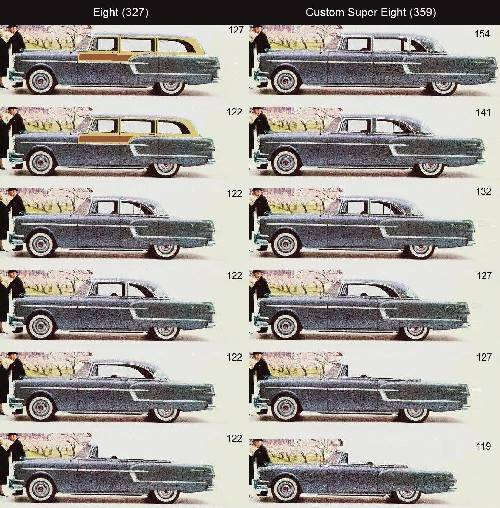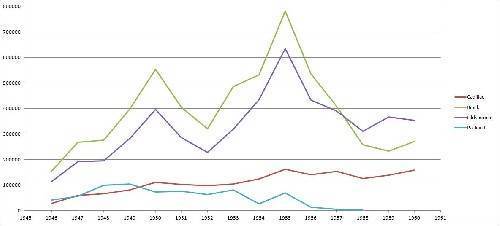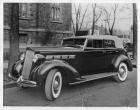|
Re: 1954 Packard What-If Showroom
|
||||
|---|---|---|---|---|
|
Home away from home

|
One thought about the '55 powertrains. Packard might have done well to develop a small block V8 for its entry models. Lightweight and efficient, good for about 330 CID once fully developed, rolling down the same line at Utica.
Posted on: 2013/3/26 19:19
|
|||
|
||||
|
Re: 1954 Packard What-If Showroom
|
||||
|---|---|---|---|---|
|
Just can't stay away

|
This seems like a sounder and more sustainable business model than any merger, few of which ever worked out in the long term. Packard needed to be Packard to survive, it really isn't any more complicated than that. I agree with suggestion of styling commonality instantly recognizable top-to-bottom as a Packard, and also with the two-tiered V-8 plan.
While hindsight is nearly always 20/20, I think that the issues you raised were there for everyone to see even in 1954. You're correct, it was indeed a pivotal year. Sadly, they missed their opportunity and never caught up.
Posted on: 2013/3/26 20:38
|
|||
|
||||
|
Re: 1954 Packard What-If Showroom
|
||||
|---|---|---|---|---|
|
Quite a regular

|
I agree with respect to Junior and Senior lines. Mercedes has always been one brand with smaller less powerful entry level cars. I think Nance could have done a better job, but I also think Packard needed newer, younger, and more visionary management right after the war. Management after the war seemed old, tired, and not terribly interested in reestablishing Packard as the premier American luxury brand.
Posted on: 2013/3/26 21:20
|
|||
|
||||
|
Re: 1954 Packard What-If Showroom
|
||||
|---|---|---|---|---|
|
Home away from home

|
Hi
That's an impressive line-up, something that would have been totally unexpected from Packard. Had this arrived concurrent to the major restyles of competitors Olds, Buick and Cadillac, Packard would have had a better chance of staying in the running for sales. Standing pat when the competitors sprung attractive new styling was a formula for getting trumped in the market. The Senior models would have become more impressive and luxurious, held buyer attention just when it was needed most. Juniors, with an improved trim and finish level not previously associated with most Juniors, should have enticed more buyers. No customer ever objected to being given more for their money. Upgrading all models to be preceived as simply two different sizes of luxury Packards would have been a bold approach in a market long used to size and appearance as indicative of model status. One would like to think the buyers of the era would have responded positively. Steve
Posted on: 2013/3/28 7:55
|
|||
|
||||
|
Re: 1954 Packard What-If Showroom
|
||||
|---|---|---|---|---|
|
Home away from home

|
These are some impressive what ifs. I don't know if such a lineup would have been practicable for a company making as few cars as Packard. Some of the styles would have required a big investment in tooling for only a few hundred, or few thousand sales.
It always bothered me that Packard changed looks so slowly from 1951 to 54. I know on close examination they did change them but the changes were so subtle, at first glance they all look the same. This was very poor planning. In those years the public responded to new styles, if you did not have a brand new car you at least had to make it look new. This was not frivolous. An all new body, if it caught the public eye, could set new sales records. The second year, no matter how good the car, you would expect sales to drop by 1/3 or more, just because it was not fresh in the showroom. In succeeding years, sales would drop again. To put this in perspective if the first year sold 100,000 the second year would sell 70,000, the third year 45,000 fourth year 30,000. This is more or less what happened to Packard. It happened to everybody. This is why companies restyled or face lifted their cars every year. If Packard followed the usual industry practice they would have had a new car in 1951. 1952 would have been the same car with enough trim changes that you could tell one year from the other. 53 would have been a face lift with new grille, new tail lights, new trim. 54 would have been an all new car. They should not have kept the same grille for 4 years and the same tail lights as long as they did. The 55 should have been the 54 and the 56 should have been the 55. That is, if they could not afford a complete new car for 54. Then there was the skimpy selection of models. I agree they were not competing successfully with Cadillac, the Patrician being the only model solidly in the Cadillac class, and it only available as a 4 door sedan. Would it have been possible to put the hardtop body on the senior long wheelbase chassis, with longer rear fenders? This gets back to the question of tooling costs. Packard did a lot with trim dies and interchangeable parts. What about senior rear fenders for the 2 door hardtop body? The Carribean was solidly in Cadillac territory. But had too much hand work and too expensive to build. Could they have mass produced something in a hardtop and convertible style that looked impressive but not at such a high price? The other style was the station wagon. The fifties was the hayday of the station wagon but Packard had none after 1950. I always admired the way they made the Station Sedan, using existing sedan tooling as far as possible, pieced out with wood. The wood structure required expensive hand work but the tooling cost was low. This worked well for a low production, premium price model. I'm sure the Station Sedan made a profit, and added prestige to the line to boot. I don't know why they didn't make a 51 Station Sedan on similar lines. The high sales of medium price and high price station wagons may have made it practical to tool up an all steel wagon. Convertibles, hardtops and station wagons were the most expensive body styles in any make's lineup at that time. They should have turned a profit, and added style and prestige in the showrooms and on the street as well. I'm afraid Packard had a stuffy, old fashioned image at the time. I know they did this deliberately to position themselves apart from other, gaudier cars. But it turned out to be a mistake - in the early fifties the public wanted gaudier cars, hardtops, chrome, tailfins, and 2 tone paint jobs. If they had made more of an effort in that direction, along with getting a V8 a few years earlier, things might have worked out different.
Posted on: 2013/3/29 10:52
|
|||
|
||||
|
Re: 1954 Packard What-If Showroom
|
||||
|---|---|---|---|---|
|
Home away from home

|
Agreed they were not keeping pace. Wouldn't have begrudged them for standing pat if they had had a timeless design that needn't have been tampered with, but the contour cars, though nice, left the door open for classic Packard tailoring.
That rule of diminishing sales seems to be true unless a marque is on a roll, and boy did Packard need to get on a roll! Cadillac sales went up most of the years in question whether their design was new or carryover. Have posted this sales chart before but might be worth posting again. Had Packard simply kept pace with Cadillac from 1954 on it would have consistently sold 100,000 units annually. That's with the low priced cars included, which I would argue should not have been offered. With only $3000 and up cars beginning in 1954, and with a much more refined design and a properly proportioned series of seniors, the company might have sold 40,000 or more cars that year and made a lot more money on each. That was the key.. max margin, not max volume. The what-if line-up would have cost them no more to developed than the 55s. The limo roof was already done... was probably simply an insert welded into a standard roof. The middle doors were also done. Nance just needed to cut a deal with Feldmann at Henney to get the tools. New tooling wasn't what was needed to improve them, just good old fashioned cutting and welding. Same with the speedster... 99% labor, 1% new tooling. Price them as cost plus, take whatever volume comes and make as much hay with the advertising as possible. Certainly a company that could take the complicated Merlin engine and build it efficiently and improves its performance could figure out how to efficiently make some clever low volume cars. The hardtop that you mentioned on the long wheelbase was absolutely in the cards. That's what the Four Hundred was. Lots of things were possible. Was thinking about how the '56 Executive sales took off immediately. That was getting closer to the type of entry Packard that the company, imho, needed to work towards. Nance and his team fought this tooth and nail but in the end the market told them what to do. Will post a '57 what-if showroom soon that is based on the planned Predictor-sytled cars and follows the logic of the proposed '54 showroom. Fascinating possibilities, the basic design having much to offer.
Posted on: 2013/3/30 15:39
|
|||
|
||||

 (237.40 KB)
(237.40 KB)








